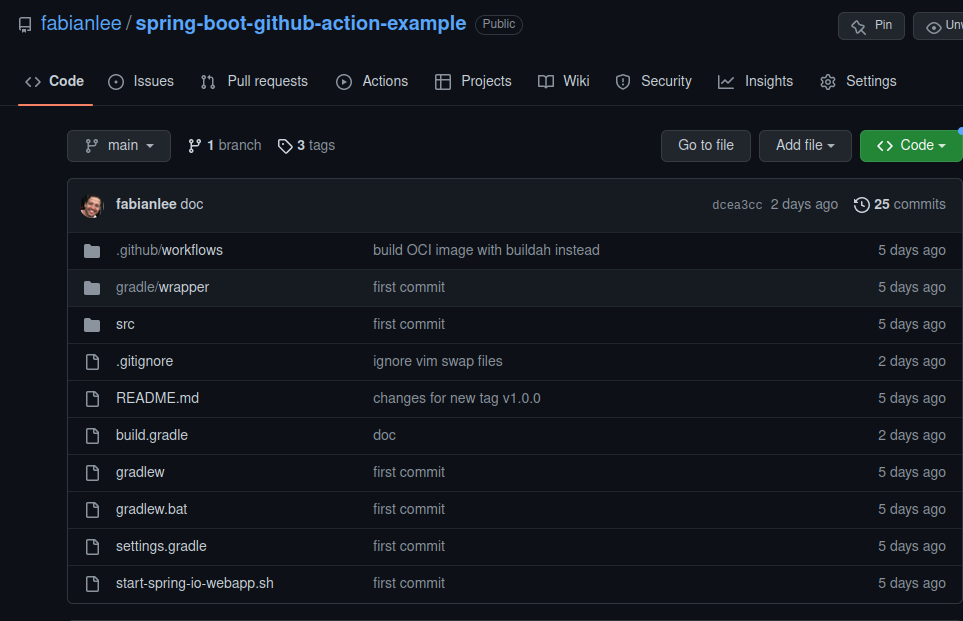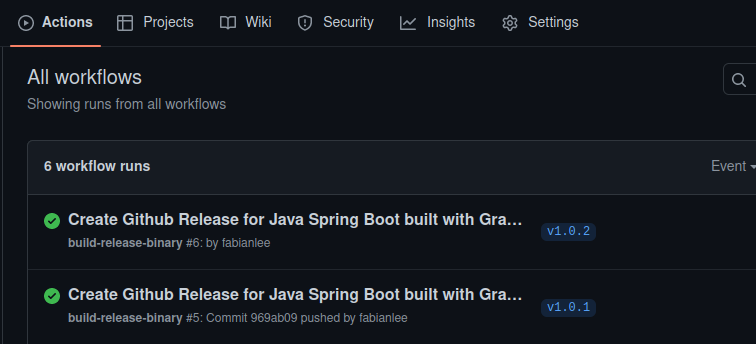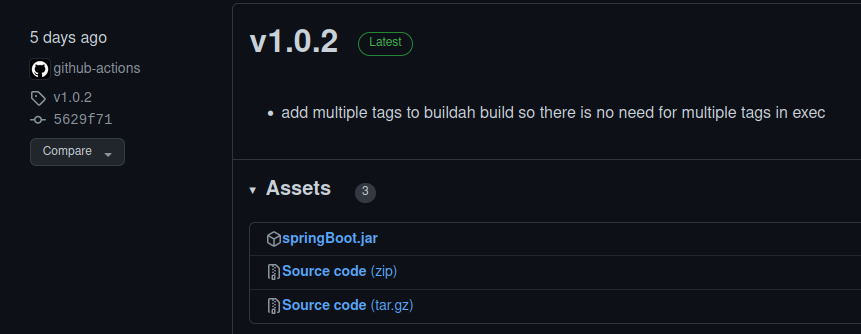![]() Github Actions provide the ability to define a build workflow directly in Github. The workflow steps are defined as yaml and can be triggered by various events, including a code push, branch, or tagging in the repository.
Github Actions provide the ability to define a build workflow directly in Github. The workflow steps are defined as yaml and can be triggered by various events, including a code push, branch, or tagging in the repository.
In this article I will detail the steps of creating a simple Spring Boot web application that when tagged with a semantic value (e.g. ‘v1.0.1’) will package the git commit messages as Release Notes and the binary Jar as a release in the repository.
Prerequisites
OpenJDK 17+ for testing local compilation
# view candidate list of JDK sudo apt search openjdk-* | grep '^openjdk\-' | grep '\-jdk' sudo apt install openjdk-17-jdk
Github CLI for creating github repo from console
See my article here for installing the Github CLI
Create Spring Boot web starter project
A convenient way of getting the basic layout and scaffolding of a Spring Boot project is to use start.spring.io to download a project starter.
# setup project values
id=spring-boot-github-action-example
artifact_id=$id
SpringAppClassName=SpringMain
version="1.0.0"
groupId="org.fabianlee"
javaVersion=17
springBootVersion=2.7.5
# returns archive containing SpringBoot project, extract
curl -s https://start.spring.io/starter.tgz \
-d type=gradle-project \
-d dependencies=web,prometheus,devtools,actuator \
-d javaVersion=$javaVersion \
-d bootVersion=$springBootVersion \
-d groupId=$groupId \
-d artifactId=$artifact_id \
-d name=$SpringAppClassName \
-d version=$version | tar -xzvf -
# validate files have been created in directory
cd $id
ls -l
You now have a directory named “spring-boot-github-action-example” containing all the basic structure and files required for a Spring Boot web application.
You can copy-paste the commands above, or download start-spring-io-webapp.sh from my github.
Test Spring Boot web locally
This minimal web application will create a web server on port 8080 when run locally. Validate by compiling and running the Spring Boot web app.
# locally compiles Spring Boot jar ./gradlew bootJar # web server running locally on 8080 ./gradlew bootRun
From another console (or even a local browser), you should be able to get a valid HTTP response from port 8080.
# test from another console
$ curl http://localhost:8080/actuator/health
{"status":"UP"}
Modify build.gradle
Then we need to customize the build.gradle file to support building the Spring Boot jar with a static name, to make it easier to work with.
You can download my full build.gradle here, or copy-paste the contents below.
plugins {
id 'org.springframework.boot' version '2.7.5'
id 'io.spring.dependency-management' version '1.0.15.RELEASE'
id 'java'
}
// ADDED as source of plugins
repositories {
mavenCentral()
}
group = 'org.fabianlee'
version = '1.0.0'
sourceCompatibility = '17'
// ADDED want consistent name for jar
bootJar {
archiveFileName = "springBoot.jar"
}
dependencies {
implementation 'org.springframework.boot:spring-boot-starter-actuator'
implementation 'org.springframework.boot:spring-boot-starter-web'
developmentOnly 'org.springframework.boot:spring-boot-devtools'
runtimeOnly 'io.micrometer:micrometer-registry-prometheus'
testImplementation 'org.springframework.boot:spring-boot-starter-test'
}
tasks.named('test') {
useJUnitPlatform()
}
Create Github repository
Let’s go ahead and create the remote Github repository for this starter project and our Dockerfile and build.gradle modifications. We will add the Github Action workflows in the next sections.
# create remote repo (the 'id/repo' from output will need to be used below)
$ CURDIR=${PWD##*/}
$ gh repo create $CURDIR --public
✓ Created repository fabianlee/spring-boot-github-action-example on GitHub
# initialize repo and add files
git init
git add *
git add .gitignore
# commit files and create main branch
git commit -a -m "first commit"
git branch -M main
# push files to remote Github repo
# use id/repo value from above for remote name
git remote add origin https://github.com/fabianlee/spring-boot-github-action-example.git
git push -u origin main
View remote Github repository in browser
The remote repository URL is shown by using the command below.
$ git remote -v origin https://github.com/fabianlee/spring-boot-github-action-example.git (fetch) origin https://github.com/fabianlee/spring-boot-github-action-example.git (push)
Pulling this URL up in your browser should looking something like the screenshot below.

Adding Github Action, overview
We will be adding a Github Action workflow by adding a yaml manifest file into the “.github/workflows” directory of our repository.
Workflows support various triggering events, we will choose to trigger when there is push to the repository of a tag that looks like a semantic version.
These workflows are run remotely on Github-hosted runners.
Add Github Action for Boot jar release
Our workflow will kick off when any new semantic tag (e.g. v1.0.1) is pushed to the repository. I will go over key areas below, but download the full version of github-actions-release.yml from my github.
Trigger
on:
push:
tags: ['v*']
Checkout Code
Checkout and fetch all the history from the repo, because we will need this later when determining the release notes.
- uses: actions/checkout@v3
with:
fetch-depth: 0 # get all tags, needed to get git log
ref: main
Java and Gradle setup
Install Java with setup-java on the Gitlab runner.
- name: setup Java
uses: actions/setup-java@v3
with:
java-version: '17'
distribution: adopt
cache: gradle
Build Spring Boot jar
Then we have gradle build the Spring Boot jar.
- name: Execute Gradle build
run: ./gradlew bootJar
Build Release Notes from commit log
Because this is a small independent project we simply want to use the commit messages made from the last semantic tag up to the current tag as the Release Notes for this release.
We take advantage of the idea that you can query for a range of commits using ellipsis.
git log fromTagName...toTagName
The script below writes the commits as a list into the file “body.log”.
- name: get semantic tag version and release notes from commit messages
id: tag
run: |
curtag=${GITHUB_REF_NAME}
major_minor=$(echo "$curtag" | cut -d'.' -f1-2)
patch=$(echo "$curtag" | cut -d'.' -f3)
# avoid empty patch number
[ -n "$patch" ] && ((patch--)) || patch=".x"
prevtag="${major_minor}.${patch}"
echo "" > body.log
if git tag | grep $prevtag ; then
git log -q ${curtag}...${prevtag} --pretty="- %s" -q --no-color >> body.log
else
git log --pretty="- %s" -q --no-color >> body.log
fi
line_count=$(cat body.log | wc -l)
echo "curtag=$curtag" >> $GITHUB_OUTPUT
echo "prevtag=$prevtag" >> $GITHUB_OUTPUT
echo "line_count=$line_count" >> $GITHUB_OUTPUT
Publish release
We finish off by using the custom release-action to push the Spring Boot jar built at ‘build/libs/springBoot.jar’ with release notes generated at “body.log” in the previous step.
- uses: ncipollo/release-action@v1
with:
name: ${{ env.GITHUB_REF_NAME }}
tag: ${{ env.GITHUB_REF_NAME }}
artifacts: "build/libs/springBoot.jar"
bodyFile: "body.log"
token: ${{ secrets.GITHUB_TOKEN }}
The “secrets.GITHUB_TOKEN” used as authentication to the Github API is a special variable pre-populated by Github.
Trigger Github Workflow
As mentioned earlier, this workflow is invoked by pushing a tag that looks like a semantic version. Here are the git commands for creating a tag and pushing it remotely.
# check for any changes that might need to be checked in first git status # create new tag that triggers workflow, push tag newtag=v1.0.0 git tag $newtag && git push origin $newtag
This will almost immediately create a workflow which you can view in real-time by going to your Github repository > Actions tab.

You can view the real-time progress by clicking into the task. The icon will indicate when the workflow is complete.
Validate Releases
The Github Release can be reached from the Github web UI. Click on “Releases” > spring-boot-github-action-example, and the releases will be listed with Release Notes and binary download available.

REFERENCES
stackoverflow, github action invoking python